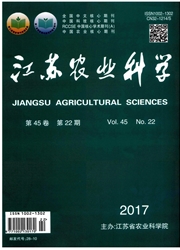

 中文摘要:
中文摘要:
[目的]比较10个水稻品种在3个播种期的器官形态和产量形成差别,并利用温度和日照等变量来预测叶片长度和植株高度等形态变化。[方法]通过连续性观察和破坏性取样,获得并分析Takanari、IR72、Sankeiso、CH86、IR65564-44-2-2、Nipponbare、Takenari、Banten、WAB450-1-B-P-38-HB和武香粳9号等10个品种在2002年5月11日、5月22日和6月19日3个播种期,整个水稻生长季节内的详细器官形态和产量形成数据,这些数据包括叶片长度、节间个数、分蘖数、株高和产量等。[结果]每个节位的最大叶片长度在生长早期逐渐上升,后期逐渐下降;品种CH86和Banten叶片长度分别在4个籼稻品种和6个粳稻品种中最长。品种节间个数和株高随着播种期推迟而减少,其中品种CH86的节间个数和株高最大。10个品种中,武香粳9号籽粒产量最大,籽粒产量、穗数、每穗粒数、千粒重,品种间差异显著,其中籽粒产量变化幅度在4358-7443kg ha-1,穗数变化幅度在158-330×104ha-1。该研究中,未发现籽粒产量与分蘖数和株高之间存在直接关联。[结论]利用本研究所获得的数据构建了叶片长度和株高动态变化等经验回归模型,分析了品种间器官形态和产量形成差异,结果将被用于构建更为机理的模型和进行水稻生产调控。
 英文摘要:
英文摘要:
[Objective] The study aimed to compare the difference of organ morphology and yield composition in 10 rice cultivars with 3 sowing date,and to correlate leaf length and plant height with exogenous variables like temperature accumulation and sunshine duration.[Method] Detailed data of organ morphology and yield component were obtained and analyzed through repeated field observations and destructive samplings over the growing season,including leaf length,node number,tiller number,plant height and grain yield of 10 rice cultivars(Takanari,IR72,Sankeiso,CH86,IR65564-44-2-2,Nipponbare,Takenari,Banten,WAB450-1-B-P-38-HB,Wuxiangjing 9) with 3 sowing dates(May 11,May 22,and June 19,2002).[Result] Max leaf length for each node increased at the early growth stage and decreased at the later growth stage.The leaf length of CH86 and Banten was the maximum in 4 Indica cultivars and 6 Japonica cultivars,respectively.Node number and plant height decreased with the later sowing date,and that of CH86 was the maximum.The maximum grain yield was found in Wuxiangjing 9,and the greatest genotypic variation existed in rice yield,panicle number,spikelet per panicle,and grain weight;the grain yield ranged from 4 358 to 7 443 kg ha-1;the panicle number ranged from 158×104 to 330×104 ha-1;no direct correlation between yield,tiller number and plant height was observed in this experiment.[Conclusion] Empirical regression fitting of the resulting data was developed for leaf length and plant height prediction and yield component comparison,which could be used to construct deeper and more mechanistic models or to optimize rice growing conditions.
 同期刊论文项目
同期刊论文项目
 同项目期刊论文
同项目期刊论文
 期刊信息
期刊信息
